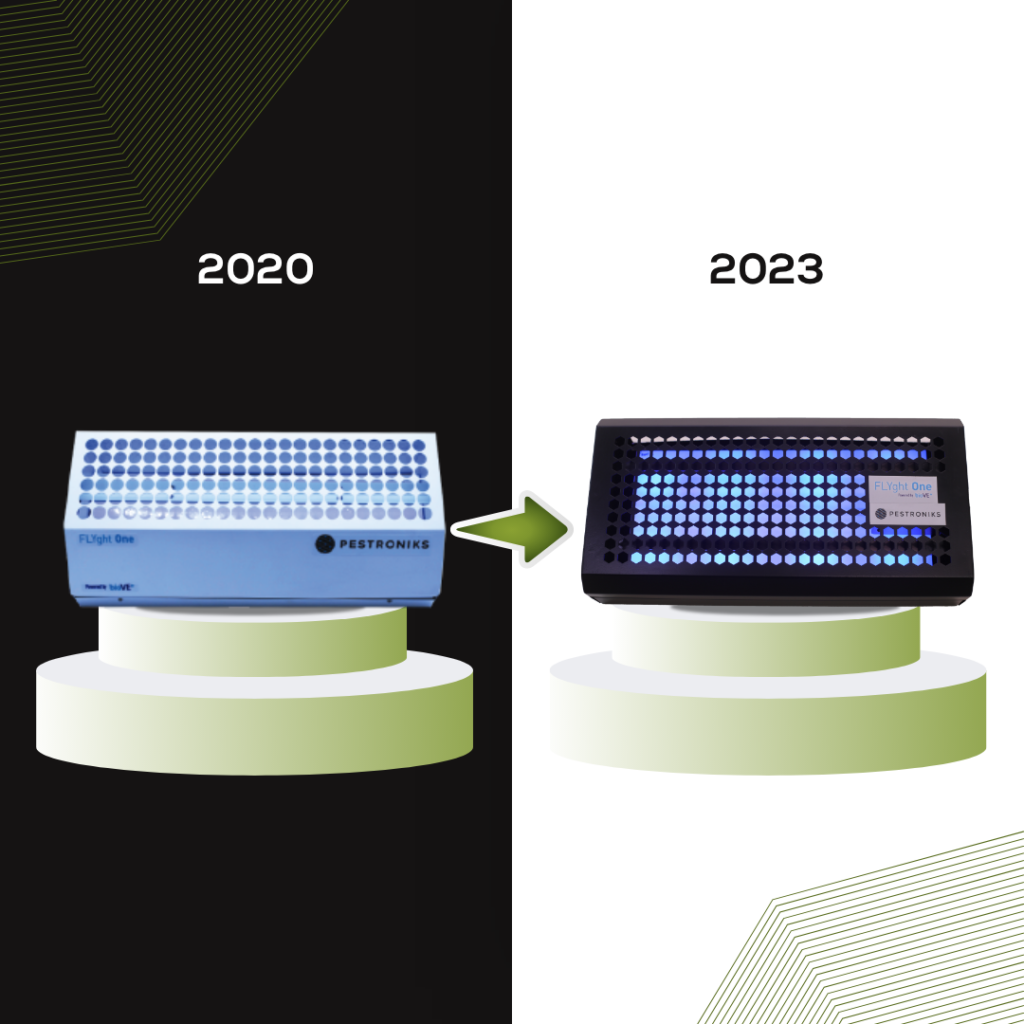
When we recently introduced the black FLYght One to customers, we didn’t change just the color of the trap but far more.
Here is the three-year story of FLYght One, India’s first UV LED flycatcher.
The beginning
We developed the first FLYght trap prototypes in late 2019. After confirming the design would work, we produced evaluation samples in early 2020, just before the advent of the COVID-19 pandemic.
Pandemic-induced lockdowns slowed product development, and we waited till July 2020 to launch FLYght One, the first Pestroniks Innovations Pte. Ltd. product.
FLYght versus fluorescent tube flycatchers
We made many changes to the flycatcher design through the enormous design flexibility that FLYght One’s eight LEDs allowed us.
As we were free from housing three fluorescent tubes and the ballast common to second-generation flycatchers, we could significantly reduce the size of our UV LED flycatcher.
Like any other product, the FLYght range also has evolved with the FLYght Duo that arrived in 2021, having improved features over the FLYght One.
Over the past year, to improve the look, feel, and performance of the FLYght One, we returned to the drawing board to reconfigure it for enhanced housefly capture.
Using the feedback from our customers, we re-engineered the FLYght One to the new unit now available to customers.
The old versus new FLYght One
As we retained the product’s functional features, both FLYght One versions share some features, as described below. Further, we have highlighted in our description the new features of the FLYght One beginning January 2023.
What remains the same in both versions
Metal housing: We continue to use steel in FLYght One trap which makes them sturdy and rugged compared to traditional plastic-bodied flycatchers that are prone to damage and have high parts replacement costs.
UV LEDs and bio-VE+: Both trap versions have eight X 1W LEDs and a bio-VE+ board. The bio-VE+ board is a bio-Visual Enhancer that reflects the UV from the LEDs after enhancing the wavelengths and intensity of such light. The blue glow emanating from the bio-VE+ board of all FLYght traps contains houseflies attracting UV wavelengths.
Glue board : Both the old and new FLYght Ones are usable with the universal glue board that is 418 mm X 283 mm.
Flies hidden from view : Like in all FLYght traps, the new FLYght One’s glueboard at the back of the trap is hidden from view, and people near the trap can’t see any of the houseflies it has trapped other than by taking the glueboard out of the trap.
What is different in the new FLYght One
Color: The all-black FLYght One stands out in any setting in contrast to the all-white FLYght One we made earlier, leading us to proudly introduce our ‘Machine-in-Black (MIB)
Contrasting colors attract houseflies more, and the black exterior of the FLYght One juxtaposed with the white color of its bio-VE+ board has higher housefly attraction than a white bio-VE+ board inside a white FLYght One.
Size: The new FLYght One has a length X width X depth of 476 X 237 X 98 mm versus the 425 X 196 X 112 mm of the old FLYght One. The FLYght One is now longer and wider than its older version.
The new trap is heavier by 500 gm. at 2.75 kg. against the 2.25 kg. of its previous version.
However, the FLYght One is still very light compared to other flycatchers in the market, and a technician can easily lift it with one hand for installation and maintenance.
Wider bio-VE+ board : The bio-VE+ board of the new FLYght One is 2X the width of the old one. We are still researching whether the wider bio-VE+ board attracts more houseflies to the trap.
Board position : The new FLYght One allows the insertion of the bio-VE+ board horizontally and the glue board vertically, letting users make board changes easily and quickly.
We have simplified glueboard use and position by having a single slot for the glueboard at the back of the trap. In the old FLYght One, users had to make two pieces of the glueboard and insert them into the two slots of the trap. Thus, our customers now save time they would have spent readying two pieces of the universal glueboard for use in a FLYght One trap.
More and different housefly entry holes : The old FLYght One has 110 round holes through which houseflies enter the trap. The new FLYght One has 226 hexagonal holes through which houseflies enter it. Our research has shown a difference in catch rates of hexagonal trap openings compared to round openings.
Pricing : We offer the new FLYght at a 19% lesser price than the older FLYght One, helping customers benefit from an overall lesser purchase price and the low cost of ownership.
As the pioneers of India’s UV LED fly catcher segment, we have interacted with hundreds of customers and introduced them to our novel technology. We continually improve our user experience by simplifying our products to make them easy to install and maintain.
For example, a user can install FLYght traps in less than five minutes as they only have to remove the release paper of the glueboards before powering the trap for the first time. We call it ‘plug and flay’ technology in which our customers plug their FLYght flycatchers and flay houseflies in the premises.
Interacting with customers in Sri Lanka, we have found that the rising electricity prices make the FLYght range of flycatchers more attractive to customers looking for lower electricity costs for housefly monitoring.
We are confident that 2023 will be the inflection year in which hundreds of Indian customers will switch from second-generation flycatchers with fluorescent tubes to Pestroniks Innovation Pte. Ltd.’s third-generation UV LED flycatchers.
